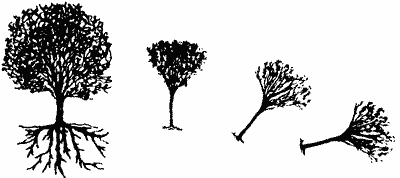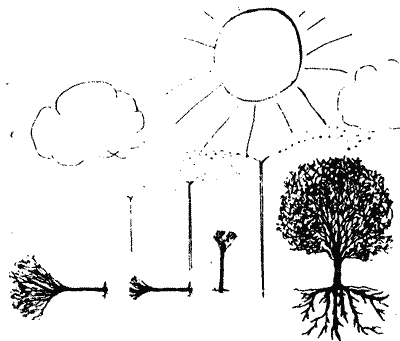
RESETTING WIND-DAMAGED TREES

Immediate action is necessary to reset trees blown over or loosened in soil by hurricanes or windstorms. In brief, the following steps should be carried out as soon as possible to save as many trees as you can.
1. Scoop out with a potato rake, hoe, shovel, or powered equipment whatsoever soil is necessary to create a hole for the uncovered roots of the tree that is to be reset. This is not necessary if tree roots have not been broken nor the tree blown over and roots exposed. However, Step No.5 does apply if tree roots have been disturbed by wrenching or twisting.
2. With pruning saw or clippers, remove or prune torn or severely damaged roots, or roots that would be in the way of resetting the tree easily. It will also be necessary to remove those roots such as 'tap roots' which had penetrated straight down into the ground. These roots, if not removed, will 'prop' the tree and interfere with resetting at the proper level, or the tree will have large air spaces beneath it.
3. With pruning saw or clippers, begin cutting back the top of the tree. Many trees, if roots were not too badly damaged on the lee side, will tend to reset themselves as tops are removed and top weight is reduced. If the tree does not try to raise itself, then reduce the top portion in area to correspond to what, in your judgement, is the remaining portion of active roots underground. It is important to follow proper pruning practices such as cutting back to forks, crotches or stems, leaving no stubs.
4. Raise the tree.
5. Fill in with soil around all roots and 'flood in' soil with plenty of water, making certain that no cavities, air spaces, or pockets are left underground.
6. Trees which have had heavy canopies of leaves will have branches that cannot take exposure to full sunlight because they have been growing in shady and humid conditions. It is necessary therefore, to whiten the trunks and branches of these trees to prevent 'scalding' or 'sunburn' by the direct rays of the sunlight.
White water-based vinyl, latex or acrylic paints have proven to be highly effective, non-toxic and durable for reflecting the sun to prevent heat damage. Probably they also reduce moisture loss from trunks and branches. Traditionally, white washes have been used for this purpose.
A standard formula for white washes have been used for this purpose.
• Lime .........50 lbs
• Water........10 gals
• Salt............4½ lbs
If quicklime is used, slake the lime with water in such a way as to prevent burning of the lime and then add the salt. This may be diluted to a suitable consistency for application. If it is to be used in a sprayer, it will have to be strained and diluted more than would be necessary for brush application. It has been found that 3 to 5 pounds of zinc sulfate may be substituted for the salt with better results.
Dissolve the zinc sulfate first in water and use this in diluting the slaked lime. White wash may be applied either by brush or may be thinned sufficiently with water to put through a grove sprayer and/or orchard guns. It is advisable at times to add a sticker spreader or wetting agent.
7. Prop the tree if necessary. Usually trees which have been blown over with one-half the roots torn need to be propped on one side.
8. Regular irrigation should be followed if soil water is not sufficient.
9. Light application of fertilizer may be applied shortly after the trees have been reset.
10. If trees cannot be reset immediately, try to shade exposed roots until trees can be reset. Also shade or whiten portions of the trunk exposed to the sun. This is important. 'Sunburn' occurs rapidly and may be disastrous for 'flat planted' or shallowly planted trees.
11. Augered holes under the trees or around the drip line of the tree will provide deeper rooting and may prevent future windfalls.

DATE: January 1987
* * * * * * * * * * * * *
